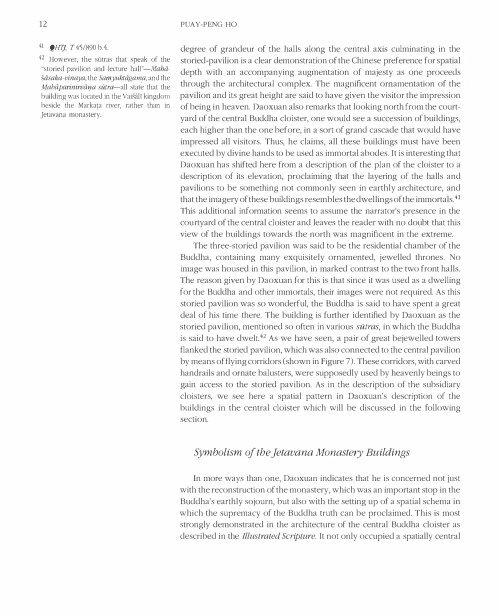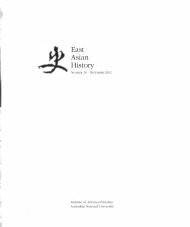(Puay-peng Ho) (PDF 4MB - East Asian History
(Puay-peng Ho) (PDF 4MB - East Asian History
(Puay-peng Ho) (PDF 4MB - East Asian History
- No tags were found...
Create successful ePaper yourself
Turn your PDF publications into a flip-book with our unique Google optimized e-Paper software.
12PUA Y-PENG HO41 QHTf, T 45/890 bA.42 <strong>Ho</strong>wever, the slitras that speak of the"storied pavilion and lecture hall"-Mahasasaka-vinaya,the Sa1!lyuktagam .a, and theMahaparinirva/Ja sutra-all state that thebuilding was located in the Vaisalj kingdombeside the Marka\a river, rather than inJetavana monastery.degree of grandeur of the halls along the central axis culminating in thestoried-pavilion is a clear demonstration of the Chinese preference for spatialdepth with an accompanying augmentation of majesty as one proceedsthrough the architectural complex. The magnificent ornamentation of thepavilion and its great height are said to have given the visitor the impressionof being in heaven. Daoxuan also remarks that looking north from the courtyardof the central Buddha cloister, one would see a succession of buildings,each higher than the one before, in a sort of grand cascade that would haveimpressed all visitors. Thus, he claims, all these buildings must have beenexecuted by divine hands to be used as immortal abodes. It is interesting thatDaoxuan has shifted here from a description of the plan of the cloister to adescription of its elevation, proclaiming that the layering of the halls andpavilions to be something not commonly seen in earthly architecture, andthat the imagery of these buildings resembles the dwellings of the immortals.41This additional information seems to assume the narrator's presence in thecourtyard of the central cloister and leaves the reader with no doubt that thisview of the buildings towards the north was magnificent in the extreme.The three-storied pavilion was said to be the residential chamber of theBuddha, containing many exquisitely ornamented, jewelled thrones. Noimage was housed in this pavilion, in marked contrast to the two front halls.The reason given by Daoxuan for this is that since it was used as a dwellingfor the Buddha and other immortals, their images were not required. As thisstoried pavilion was so wonderful, the Buddha is said to have spent a greatdeal of his time there. The building is further identified by Daoxuan as thestoried pavilion, mentioned so often in various siUras, in which the Buddhais said to have dwelt.42 As we have seen, a pair of great bejewelled towersflanked the storied pavilion, which was also connected to the central pavilionby means of flying corridors (shown in Figure 7). These corridors, with carvedhandrails and ornate balusters, were supposedly used by heavenly beings togain access to the storied pavilion. As in the description of the subsidiarycloisters, we see here a spatial pattern in Daoxuan's description of thebuildings in the central cloister which will be discussed in the followingsection.Symbolism of the jetavana Monastery BuildingsIn more ways than one, Daoxuan indicates that he is concerned not justwith the reconstruction of the monastery, which was an important stop in theBuddha's earthly sojourn, but also with the setting up of a spatial schema inwhich the supremacy of the Buddha truth can be proclaimed. This is moststrongly demonstrated in the architecture of the central Buddha cloister asdescribed in the Illustrated SCripture. It not only occupied a spatially central
















